Key Things to Consider Before Joining a Yoga Teacher Training
Yoga Teacher Training is a life-changing journey that is demanding but also transforms you more deeply and meaningfully. There are key things to consider before joining a yoga teacher training session, which further help you pursue your teaching professionally. This article covers yoga teacher training considerations, benefits, its challenges and rewards, along with why to choose us (Himalayan Yoga Academy). Yoga Teacher Training is not only about learning various elements of Yoga but also about knowing Yoga within to evolve yourself better as a person or an individual physically, mentally, and spiritually.
Key Things to Consider Before Joining a Yoga Teacher Training
A. Your Personal Practice Level
Yoga Teacher Training is both physically and mentally demanding. It is more beneficial if you have familiarity with yoga practices. Your personal practice level helps to build a foundation in yoga asanas (postures), pranayama (breath work), and meditation. Most YTT programs accept all levels, so you just have a passion as a practitioner to learn and absorb the material.
B. The Yoga Style
Yoga styles are broad, with disciplines such as Hatha, Vinyasa, Ashtanga, Iyengar, Kundalini, and many more. Yoga practitioners must choose a program that matches their style of yoga the most. Make sure the selected training program aligns with your personal preferences and long-term goals as a teacher.
C. The Duration and Commitment
Yoga Teacher Training demands intense commitment as the duration ranges from 200 to 500 hours. So it may take several months to complete a training program. Remember that joining a training session is not just about attending classes, but also about self-study, homework, and practice teaching. Thus, to join a class, prepare yourself both physically and mentally to balance your work, family, and other responsibilities.
D. The Program Cost
Yoga Teacher Training program costs can be expensive, considering factors like course duration, location, amenities, travel, textbooks, materials, etc. It may range from a few hundred dollars to even cost a lot if the reputation of the Yoga institution is involved. Select the training program that best aligns with your interests and look for payment plans or scholarships if you wish to enroll in your desired institution. Overall, proper financial planning and preparation are essential to joining a class.
E. The Right Environment
The right training environment is very important as it creates an uplifting environment to focus deeply. Not only is it necessary to select experienced instructors and reputable institutions. But it is also necessary to But it is also necessary to But it is also necessary to make sure the training space is well-equipped and comfortable. The best way to select the right environment is to read verified past reviews and testimonials of the program that you are enrolled in.
F. Your Intentions and Long-Term Goals
Your intentions and long-term goals determine the fruitful outcome of the Yoga Teacher Training. Thus, it is best to have a clear intention that aligns with the right training program to get specialization for your career as a certified yoga teacher.
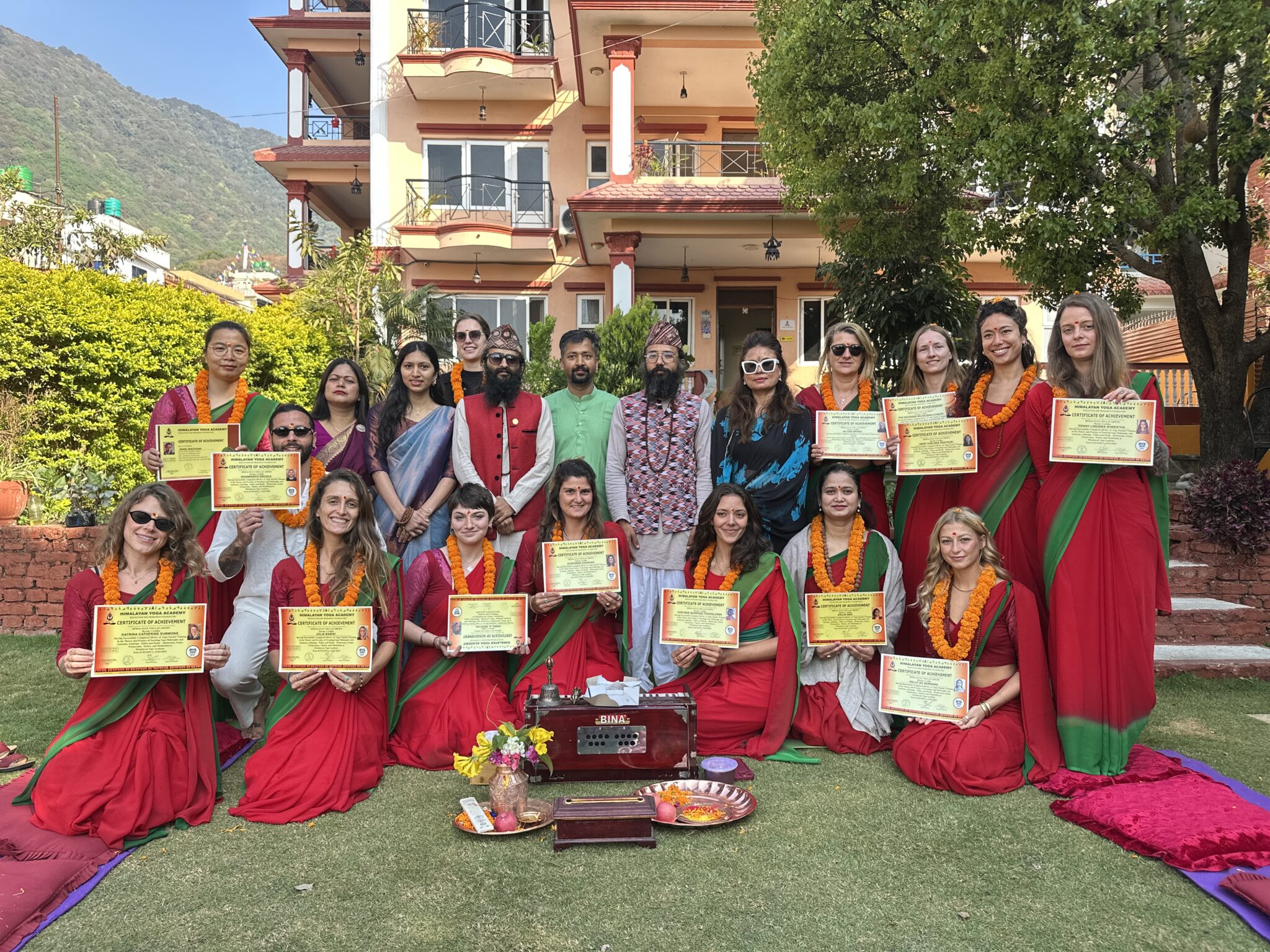
Benefits of Yoga Teacher Training (YTT)
A. Deep Understanding of Yoga
YTT deepened the understanding of Yoga through long hours of continuous practice. The knowledge of Yoga expands with an insightful understanding of the philosophy, anatomy, history, and spiritual aspects of yoga. It assists you to practice more precisely, ultimately resulting in benefiting both your body and mind.
B. Personal Growth and Transformation
YTT helps in personal growth and transformation, resulting in knowing oneself better and understanding the different aspects of Yoga in a better way. Yoga transforms both internally and externally through healing, developing self-awareness, and discovering your true potential.
C. Building a Like-Minded Community
YTT provides an opportunity to meet and build a like-minded community, attracting people from all aspects of life. The support, the connection, the motivation, along with the shared experiences of fellow participants throughout the training, provide a new sense of formation of a relationship.
D. Teaching Skills and Certification
YTT provides the teaching skills as well as a completion certificate to verify authenticity as a certified yoga instructor or teacher. The teaching skills you gain include organizing class sequences, providing adjustments, and clear communication with the students. It is your new path to lead your career in teaching yoga as a certified teacher.
E. Increased Mindfulness and Stress Relief
The long practice of Yoga builds up an ability to release stress and increase mindfulness. As a yoga teacher and as a student, the daily practice of yoga helps in leading a balanced and stress-free life with improved emotional balance, strong physical health, and mental clarity.
Also Read: Yoga Teacher Training in Nepal Courses
Why Choose Us (Himalaya Yoga Academy) for Your Yoga Teacher Training?
Himalaya Yoga Academy offers a comfortable environment and experience for aspiring yoga teachers. We have designed a program that aligns with both your personal goals and the quality of training you wish to receive. The reasons for choosing us for your Yoga Teacher Training are as follows:
Authenticity and Tradition
The authentic teachings of Yoga, with traditional yoga practices such as Hatha and Asthanga Yoga. Connect us between ancient yoga traditions and modern relevance.
Experienced and Passionate Teachers
The teachers in our academy are highly experienced, certified, and passionate about unique practicing techniques. Our teachers’ dedication and the ability to form a good relationship with practitioners help in building their students’ personal growth and professional development.
Comprehensive Curriculum
Our comprehensive curriculum for our Yoga Teacher Training offers a wide variety for our clients. They have a choice to select the right program that aligns with their preferences for Yoga practices.
The Perfect Environment for Learning
Our Yoga Academy is situated in the beautiful vicinity of greenery, offering a peaceful environment for learning. The natural aura of the academy enhances the training experience and allows you to connect more deeply with the yoga practice.
Global Community and Support
We pride ourselves on building a supportive, international community of yoga students and teachers. The practitioners come from all over the world and build good bonds and friendships that further support their personal growth.
Certification and Career Support
You’ll receive a globally recognized certificate, i.e., Yoga Alliance, which is accredited to provide you with the credentials to pursue a successful yoga teaching career. We also provide career guidance and support, helping you navigate the next steps in your professional yoga teaching journey.
Affordable and Flexible Options
Our Yoga Teacher Training is accessible to several students with affordable courses and flexible payment plans to suit various budgets. Furthermore, our location offers affordable accommodation options for international students.

Conclusion
Yoga Teacher Training is a rewarding journey that is full of challenges and inspiration for a better transformation. Thus, before joining a Yoga Teacher Training, approach it with a clear mind and practical expectations. The provided key insights before joining a Yoga Teacher Training prove beneficial when taken with the correct approach for preparation to become a certified, skilled teacher. Yoga Teacher Training transforms your life in ways you never expected.
Written By: Anjali B
Combine Yoga and Sound Healing for Deep Relaxation
Yoga practice is slowly becoming an integral part of an individual for better physical health and mental clarity. Practicing Yoga is a boon which helps an individual to calm their mind, body, and soul. Yoga serves as a peaceful escape from their hectic schedule, bringing relaxation. Yoga is powerful on its own, but when combined with sound healing, it intensifies its benefits, promoting deep relaxation and inner balance. This blog will show you how to combine Yoga and Sound Healing for Deep Relaxation.
What is Sound healing?
Sound healing is an ancient therapeutic practice that uses sound frequencies to cure physical, emotional, or energetic imbalances. The vibrations from various instruments such as gongs, singing bowls, tuning forks, and drums are used for sound healing. The main purpose of sound healing is to restore balance within the body and mind.
Also Read: Understanding Sound Healing and Sound Baths
Why Combine Yoga and Sound Healing?
Yoga prepares the body and mind to be more approachable. Sound healing complements this by deepening relaxation, slowing brain waves, and enhancing the meditative state. Together, they:
- Reduce stress and anxiety
- Balance energy and chakras
- Improve sleep and emotional well-being
- Enhance mindfulness and spiritual connection

How to Combine Yoga and Sound Healing for Deep Relaxation?
A. Start with Gentle Movement or Restorative Yoga
Choose a slow-paced style like Yin Yoga, Restorative Yoga, and Hatha Yoga as these styles help calm the nervous system and prepare you to receive sound vibrations more fully.
Yin Yoga: long-held poses target connective tissues.
Restorative Yoga: uses props to fully support the body.
Hatha Yoga: slow movements with breath awareness.
Quick Tip: Dim the lights, light a candle, and create a cozy, quiet space.
B. Incorporate Sound Throughout the Practice
You can add sound in various ways:
Live Instruments: Use singing bowls, chimes, or gongs during long holds or savasana.
Background Soundtracks: Play recorded sound baths or binaural beats during the session.
Vocal Toning/Chanting: Begin or end with “Om” or mantra chanting to activate throat chakra and vibration in the body.
Quick Tip: Place singing bowls near the body or on the mat for deeper resonance.
C. Synchronize Sound with Breath and Movement
During the yoga flow, you can:
Use soft chimes to signal transitions.
Match breathing exercises (pranayama) with tonal background sounds.
Use hand-held instruments (like rain sticks or ocean drums) during breath work or meditative stillness.
Also Try: Alternate nostril breathing (Nadi Shodhana) followed by tuning fork tones to clear energy channels.
D. End with a Sound Bath in Savasana
This is the most powerful way to combine both practices:
Lie in Savasana (Corpse Pose) fully supported with blankets and cushions.
Use crystal bowls, gongs, or voice to create layered sound.
Let participants fully surrender into the vibrations for 10–20 minutes.
Note: Sound during savasana can induce theta brain waves, leading to deep healing and vivid inner awareness.
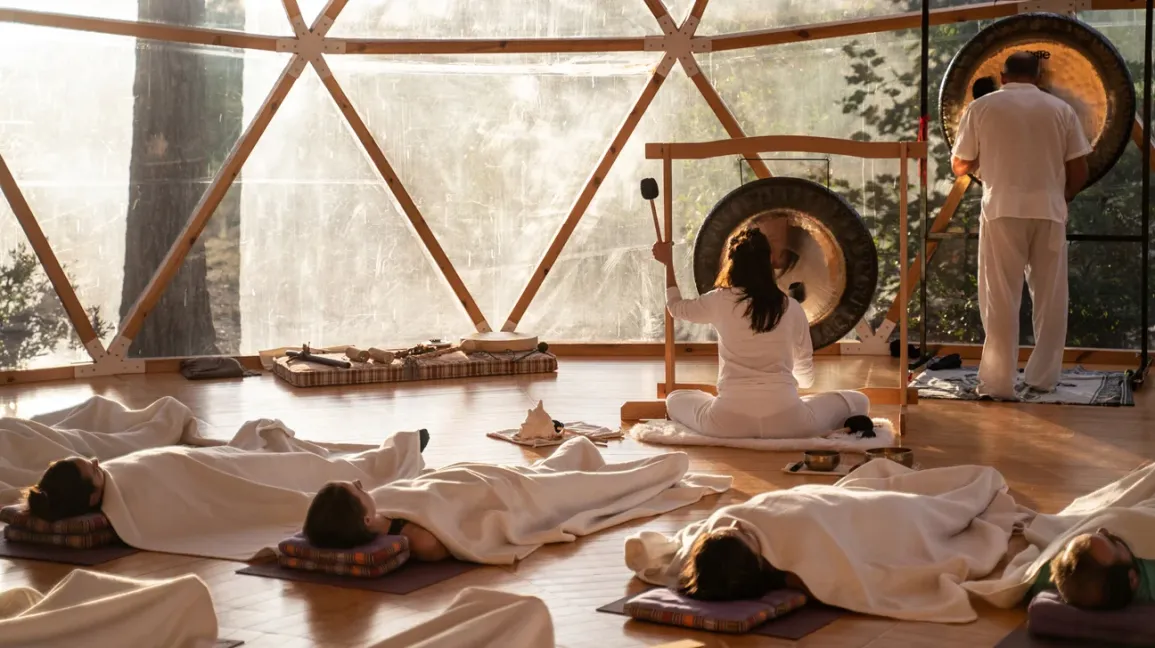
Benefits of Combining Yoga and Sound Healing
1. Deeper Relaxation
Sound slows down the mind, helping you enter a meditative state faster than yoga alone.
2. Heightened Body Awareness
Vibrations help you feel more connected to your body and breath, supporting mindful movement.
3. Energetic Balance
Different sounds resonate with different chakras, helping to clear blockages and enhance energetic flow.
4. Stress Reduction and Emotional Release
Both practices activate the parasympathetic nervous system, lowering cortisol and releasing held emotions.
5. Enhanced Spiritual Connection
Together, they open space for introspection, intuition, and inner peace.
Precautions and Considerations
Sound Sensitivity: People with anxiety or PTSD may feel overstimulated by certain instruments. Always start gently and check in.
Environment Matters: Choose a quiet, acoustically soft room to avoid harsh echoes.
Go Slow: Deep healing can bring up emotions. Practice integration after your sessions with journaling, grounding, or nature walks.
Conclusion
Combining yoga and sound healing is a deep therapeutic practice that offers deep relaxation through the power of vibration. The unison of body and sound allows an individual to connect with themselves and get to know them more deeply. So are you ready to experience it? Get ready, bring a yoga mat, a bowl (or a playlist), and surrender yourself to a quiet environment.
5 Easiest Standing Yoga Poses for Beginners
Yoga practice among individuals is blooming, which is a good indication. It shows that people are taking their health seriously. The busy life and schedule are strongly impact the lives of an individual. Thus, people are practicing yoga as it helps to keep the mind, body, and soul in balance and in shape. To practice yoga, yoga poses are the foundation which gives you brief understanding of your yoga journey. Correct yoga poses offer a better experience and are also beneficial, especially for beginners. Hence, we present the 5 easiest standing yoga poses for beginners with their steps, benefits, and cons for a smooth yoga journey.
5 Easiest Standing Yoga Poses for Beginners
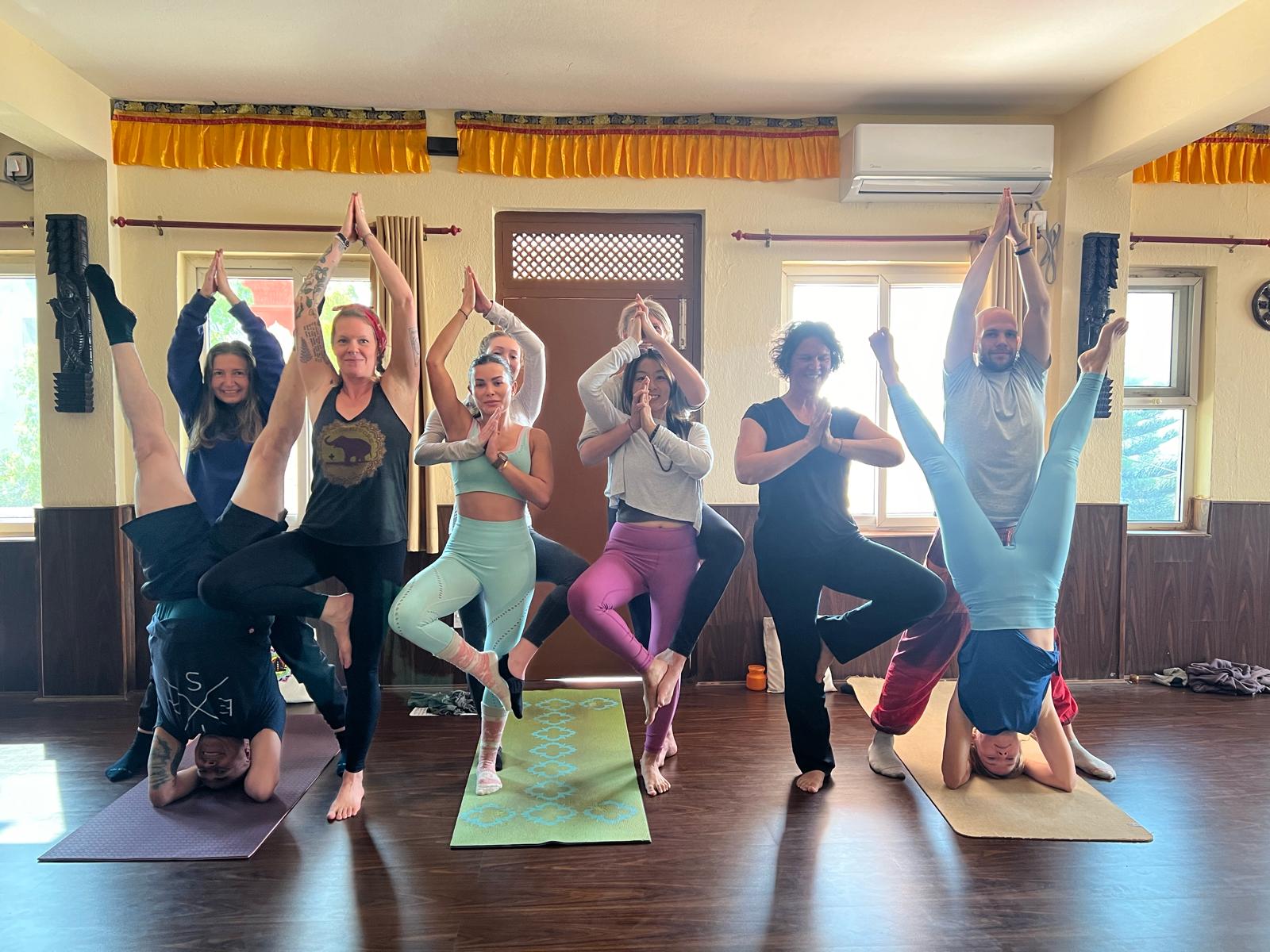
A. Tadasana (Mountain Pose)
Steps
- Stand on a mat with a straight-legged posture, the feet together, heels slightly apart, and wide-set toes.
- Draw your weight evenly into the body and slowly lift your kneecaps.
- Open your chest wide, straighten your spine, and keep your shoulders aligned over your hips.
- Stretch your hands straight up with palms facing forward.
- Tilt the crown of the head upwards without tilting the chin upwards but keeping it parallel to the ground.
- Remain in a steady pose for 15-30 seconds, breathing slowly.
- Bring your hands down and back into a normal standing position.

Tadasana Benefits
- Increases body awareness, promoting better balance and coordination
- Proper body alignment improves blood circulation and respiration
- Calms the mind and improves concentration, promoting mental focus
Tadasana Cons
- Avoid knee locking for those people who have knee problems
- Improper alignment of hips, feet, or shoulders causes strain in the lower back or knees
B. Vrikshasana (Tree Pose)
Steps
- Stand erect. Keep the feet together.
- Fold the right leg and placed it at the top of the left thighs with the toes of the right leg should point downwards.
- The right leg should perpendicular to the left leg.
- Extend your arms above your head.
- Inhale and try to make Namaskar mudra with your palms.
- Balance the pose as long as you can because balancing is of utmost importance in the Tree pose.
- Try to make your spine straight and feel the stretching from toes to fingers.
- With a deep exhale bring your arms and leg down.
- Repeat the same with the left leg. It completes one round.
- Do three-five rounds.

Vrikshasana Benefits
- Strengthen the bones of the hips and legs
- Calms and relaxes the central nervous system
- Helps to cure rheumatic pain and also treats numbness
Vrikshasana Cons
- Avoid people suffering from acute knee problems, Hip injury
- Avoid if you are suffering from migraine, insomnia, or low or high blood pressure
C. Utkatasana (Chair Pose)
Steps
- Stand erect with your feet slightly apart.
- Stretch your hands to the front with palms facing downwards. Do not bend your elbows.
- Bend the knees and gently push your pelvis down as if you are sitting in an imaginary chair.
- Be comfortable and imagine yourself doing activities sitting on a chair to get a better real.
- Ensure that you keep your hands parallel to the ground.
- With awareness, sit straight and lengthen your spine. Relax.
- Sink deeper into the chair by gradually going down but ensure that your knees don’t go beyond your toes.
- Keep going down slowly and then sit down in Sukhasana (cross-legged posture) or lie down on your back and relax.

Utkatasana Benefits
- Helps strengthen the lower back and torso
- Tones the thigh, ankle, leg and knee muscles
- Builds core and improves body balance
Utkatasana Cons
- Avoid if you have chronic knee pain, arthritis, or sprained your ankle
- Don’t practice if you have lower back pain
D. Trikonasana (Triangle Pose)
Steps
- Stand straight on the mat with medium stance (about 3 to 4 feet).
- Inhale and stretch your arms at shoulder level.
- Rotate your right foot out 90 degrees and left foot in by 15 degrees and exhale.
- Place your right hand on your right shin bone.
- Raise your left hand upward and gaze at your left thumb.
- Keep taking long, deep breaths.
- Inhale, bend the right knee, and resume the standing position.
- Repeat the same process facing right or using left side.
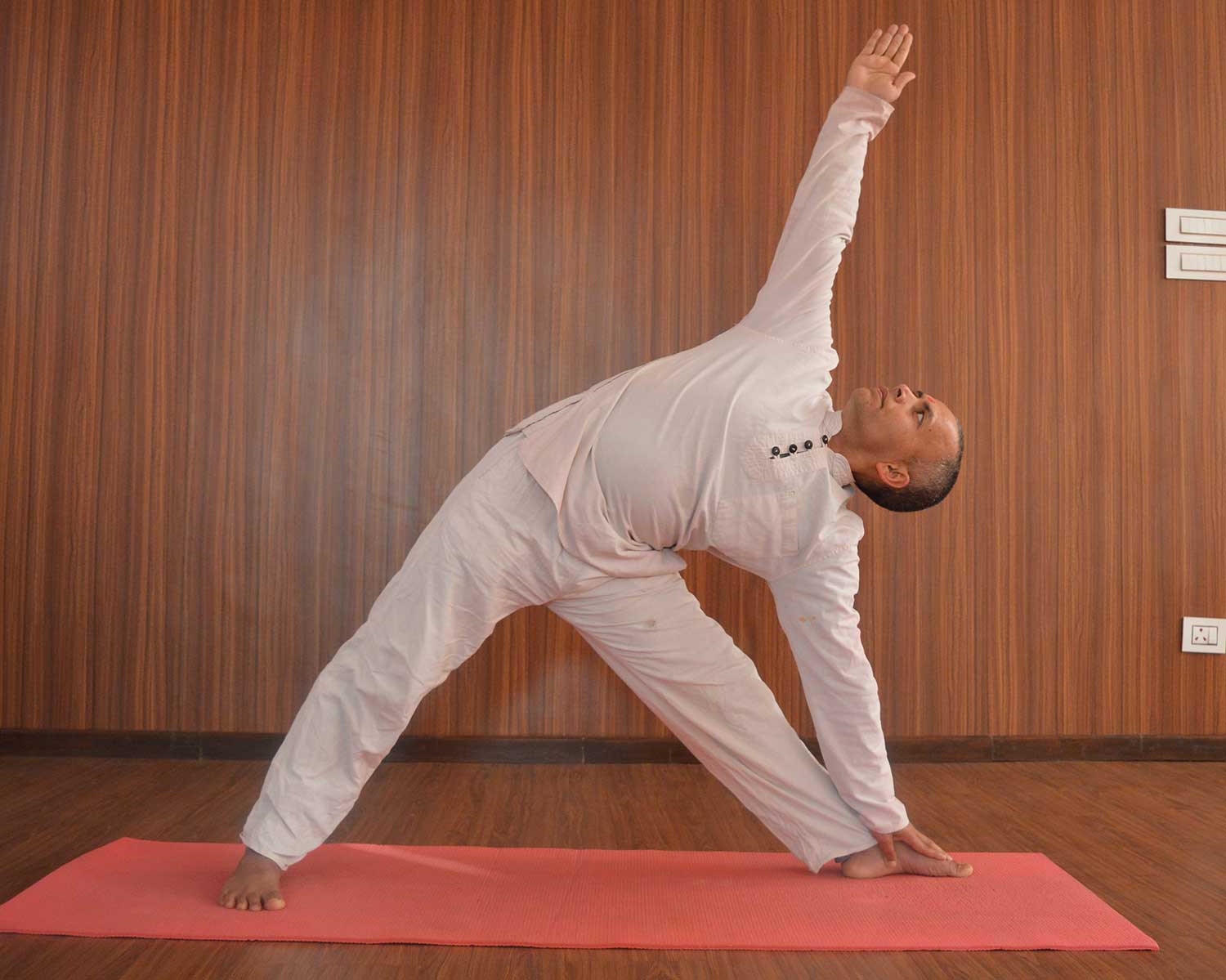
Trikonasana Benefits
- Opens the chest and promotes deep breathing
- Balance and coordination improves
- Stimulates digestion and relieves stress
Trikonasana Cons
- Incorrect alignment causes strain to the lower back, hamstrings, or neck
- Over-extension is avoided, especially with tight hips or legs
E. Uttanasana (Standing Forward Bend)
Steps
- Place your feet either width apart or together as you stand on the mat.
- Exhale, then bend forward from the hips rather than the waist area.
- Reach your palms or fingertips towards the floor slightly in front of or beside your feet. Knees can be either bent or straight.
- Lift or lengthen the front torso just a little bit after with each inhalation, and with each exhalation, release more fully into the forward bend.
- Hold steadily and evenly breathe for as long as it is comfortable.
- To come out of the pose, bend your knees until your body hit your thighs.
- Then, plant your heels firmly on the ground and softly raise your spine.
- Lastly, raise your head and shoulders.

Uttanasana Benefits
- Stretches hamstrings, calves, and back
- Relieves stress by calming the mind
- Stimulates liver, kidneys, and digestive system
Uttanasana Cons
- Immediate rise can cause dizziness
- May strain lower back if knees are locked or back is rounded
Conclusion
The 5 easiest yoga poses for beginners are simple and best to practice. These yoga poses help in strengthening the backbone, maintain the body posture, and also offer mental clarity. Practicing these easy yoga poses builds a foundation to do yoga in a proper way, creating a way to learn more yoga poses. It motivates you to build confidence and strength to practice more advanced yoga poses with ease.
Written By: Anjali B
Yogic Relaxation Techniques
In today’s fast-paced world, stress has become a part of daily life, often affecting our body, mind, and spirit. Yogic relaxation techniques offer a holistic approach to healing and rejuvenation, promoting balance and harmony on all levels of being. These ancient practices, rooted in the wisdom of yoga, help us unwind deeply, releasing tension and restoring our natural state of peace.
1. Physical Relaxation: Letting the Body Rest
The first step to total relaxation begins with the body. Physical stress can manifest as stiffness, fatigue, or restlessness. Yogic techniques help soothe the nervous system and relax muscles.
Shavasana (Corpse Pose): This is a fundamental pose used at the end of every yoga session. It involves lying flat on the back, arms by the side, and consciously relaxing each part of the body. The focus is on complete stillness and letting go.
Progressive Muscle Relaxation: This method involves tensing and releasing individual muscle groups, helping develop awareness of where tension is stored.
Gentle Asanas: Practicing restorative poses like Child’s Pose (Balasana) or Legs-Up-the-Wall (Viparita Karani) helps calm the body and prepares it for deeper relaxation.

2. Mental Relaxation: Quieting the Mind
A busy mind can lead to anxiety, insomnia, and a lack of clarity. Yogic practices help slow down mental chatter and bring about a sense of calm.
Pranayama (Breath Control): Techniques like Nadi Shodhana (alternate nostril breathing) or Bhramari (humming bee breath) balance the nervous system and calm the mind.
Yoga Nidra (Yogic Sleep): This is a guided meditation that leads the practitioner into a deep state of conscious relaxation. It is said to be as restful as several hours of sleep and is effective for reducing stress and anxiety.
Trataka (Candle Gazing): A meditative technique that involves fixing the gaze on a candle flame. It improves focus, calms the mind, and can even aid in emotional release.

3. Spiritual Relaxation: Connecting Within
True relaxation isn’t complete until the spirit is at ease. Spiritual wellness brings a sense of purpose, peace, and deep inner connection.
Meditation: Whether it’s silent meditation or mantra chanting, this practice connects you to the inner self. Regular meditation fosters self-awareness and inner peace.
Mantra Repetition (Japa): Repeating a sacred sound like “Om” or a personal mantra helps draw the mind inward, transcending ordinary thoughts and aligning with higher consciousness.
Gratitude and Intention Setting: Taking a few moments each day to reflect on what you’re thankful for and setting positive intentions nurtures a sense of contentment and spiritual clarity.
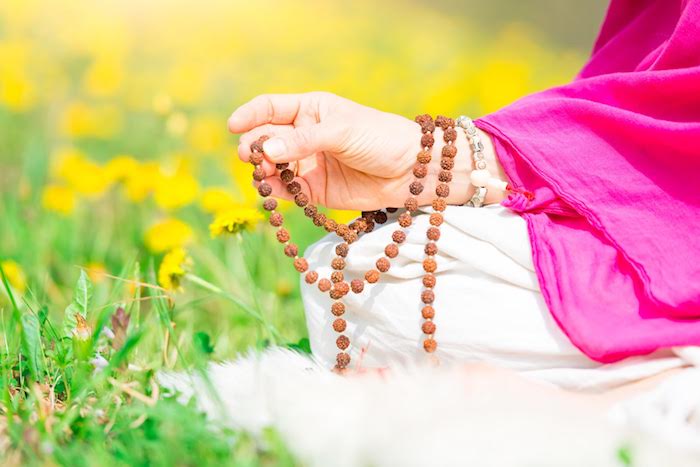
Also Read: Yogic Concept of Health
Conclusion: A Path to Wholeness
Yogic relaxation is not just about taking a break — it’s a journey toward wholeness. By combining physical stillness, mental clarity, and spiritual connection, these techniques offer deep healing and lasting wellness. Whether you’re new to yoga or a seasoned practitioner, integrating relaxation into your daily routine can transform your life from the inside out.
So take a deep breath, lie down in Shavasana, and begin the journey back to yourself — relaxed, renewed, and reconnected.
